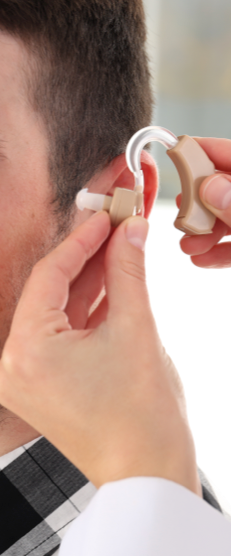All five of our senses are amazing, and that includes hearing. Whether you are awake or asleep, your ears are always “on” when they are working properly. Understanding how hearing works can help you protect this amazing sense, as well as enable you to get help in the event of hearing impairment.
Contact UsSound waves constantly vibrate in the air all around us. Whether someone is speaking, playing the piano, ringing a bicycle bell, driving a truck, hammering a nail or tapping a pencil on the table, there are sound waves constantly flowing in all directions at once. And your ear picks them up all the time without any conscious effort from you.
Your outer ear (the visible part on the side of your head) funnels these sounds down through your auditory canal, which is the corridor leading down to your ear drum. The auditory canal is lined with glands that produce wax, as well as tiny hairs. Incidentally, that ear wax that we often find annoying is actually designed to clean, lubricate and protect your auditory canal from water, fungi, bacteria and insects! Once the sound waves reach your ear drum, they cause it to tremble, which causes middle ear vibrations.
On the other side of your ear drum is the middle ear area. It is inhabited by three tiny, sensitive bones called “ossicles.” They are precisely arranged to respond to the vibrations caused by the sound waves bouncing on your ear drum. The first of these little bones is called the “hammer” (malleus). It taps on the next little bone, called the “anvil” (incus), which then vibrates the third little bone, called the “stirrup” (stapes). This middle ear chamber and the ossicles amplify the sound waves before sending them on to become electrical impulses in the inner ear.
The inner ear is an amazing structure that houses the cochlea, which changes the mechanical vibrations of sound waves into electrical nerve impulses, and your vestibular system, which helps you stay balanced and orient your body as you move through space. (This is why damage in the inner ear often affects both hearing and balance.)
The cochlea is filled with a special fluid and millions of tiny hair cells arranged throughout a corridor shaped somewhat like a snail shell. The opening of the snail shell has hair cells that detect lower sound frequencies or tones. As sounds travel through to the apex of the cochlea (or innermost reaches of the snail shell), different areas there respond to different sounds and frequencies across the noise spectrum.
Specifically, these impulses are sent to the brain’s central auditory cortex, where all of the information gathered by your ears is processed so you can tell whether you are hearing speech, the mechanical sounds of the construction equipment across the street, music playing on the radio, the toaster popping or your brakes grinding.
Hearing loss, auditory processing disorders and even balance disorders can occur when any part of this system – from the outer ear and the middle ear, to the inner ear and its hair cells and the central auditory cortex – is damaged or dysfunctional.
If you are struggling with hearing loss or balance disorders, it is important to have hearing tests conducted by an experienced audiologist so that you can begin the right hearing health care regimen to alleviate the problem and improve your ability to hear, concentrate or balance.

These are just the basics of how sounds in your environment are converted into to the electrical signals that your brain then interprets. There is so much more to know and understand, particularly if any part of this amazing system fails to work as it should. Fortunately, modern technology has given us amazing resources to correct all kinds of hearing loss problems!

To schedule an appointment to meet with one of our audiologists in Columbus, contact us today. We have six convenient locations, so you won’t need to travel far to access great hearing health care.